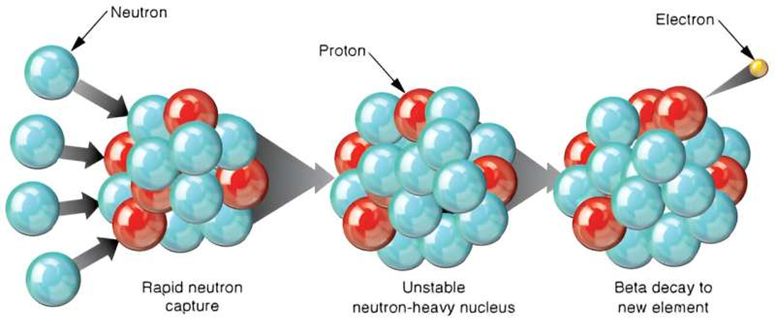Discovering an alternative cosmic source of gold

Scientists have discovered that the explosion of a low-mass neutron star could be the alternative cosmic source of lanthanides and other heavy elements, including precious metals such as gold and platinum.
Neutron stars are the collapsed cores of massive stars whose mass ranges from 10 to 25 times the mass of the Sun. After the final explosion, the star leaves behind a compact body with a mass similar to the Sun, with a diameter of about 20 kilometers. Such a compact body is stable enough to exist on its own. But in a binary neutron star system, interaction with a companion neutron star can lead to something exciting.
Normally, when two neutron stars are close enough, they merge and collide. This process is the main source of lanthanides and heavy elements in the universe. The collision can create a condition known as the r-process for the synthesis of these elements.
The first binary neutron star merger event was observed in 2017. However, the merger channel alone was not sufficient to explain heavy elements on the cosmic scale.
The team, led by Dr. Sheng-Chi Leung, assistant professor of physics at the State University of New York, in collaboration with Dr. Chun-Ming Yip, Dr. Ming-Chung Zhu and Dr. Lap-Ming Lin, of the Chinese University of Hong Kong, observed that even without a direct collision, the primary neutron star could... To lose mass to the accompanying neutron star through tidal force.
Theoretical models predict that after losing enough mass, the star becomes unstable, leading to an uncontrolled pulsation and subsequent explosion.
For their study, the team investigated whether this channel was capable of manufacturing heavy elements similar to the fusion channel.

There are very few previous studies of this process because the modeling represents a computational challenge that involves accounting for very large-scale nuclear reactions and accounting for the extreme environment surrounding the neutron star.
The team succeeded in overcoming the computational barrier and simulated how these explosions occur. To make sure the stoichiometry was calculated correctly, they used a large nuclear network of more than 3,000 isotopes combined with the latest microphysics.
Their new results confirm that a single low-mass neutron star is unstable and could explode. The chemical composition of the ejecta is very similar to that of the sun, especially in the heavy elements. This suggests that this scenario could be another important way to explain the distribution of chemical elements in the universe.
This study sheds light on one of the fundamental questions about the universe: Where do all the chemical elements come from? And how did the universe evolve from just hydrogen and helium to 118 diverse elements?
The team will continue to investigate the possibilities of detecting the explosion and improve the physics of the inputs to make the simulations more realistic.
Source: phys.org

